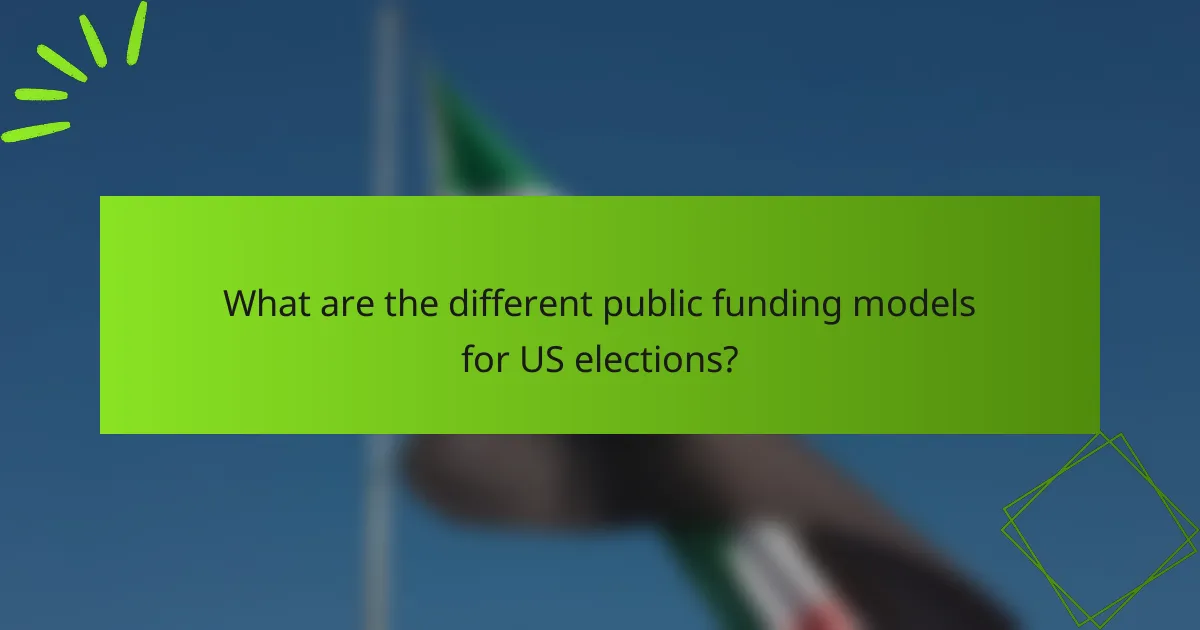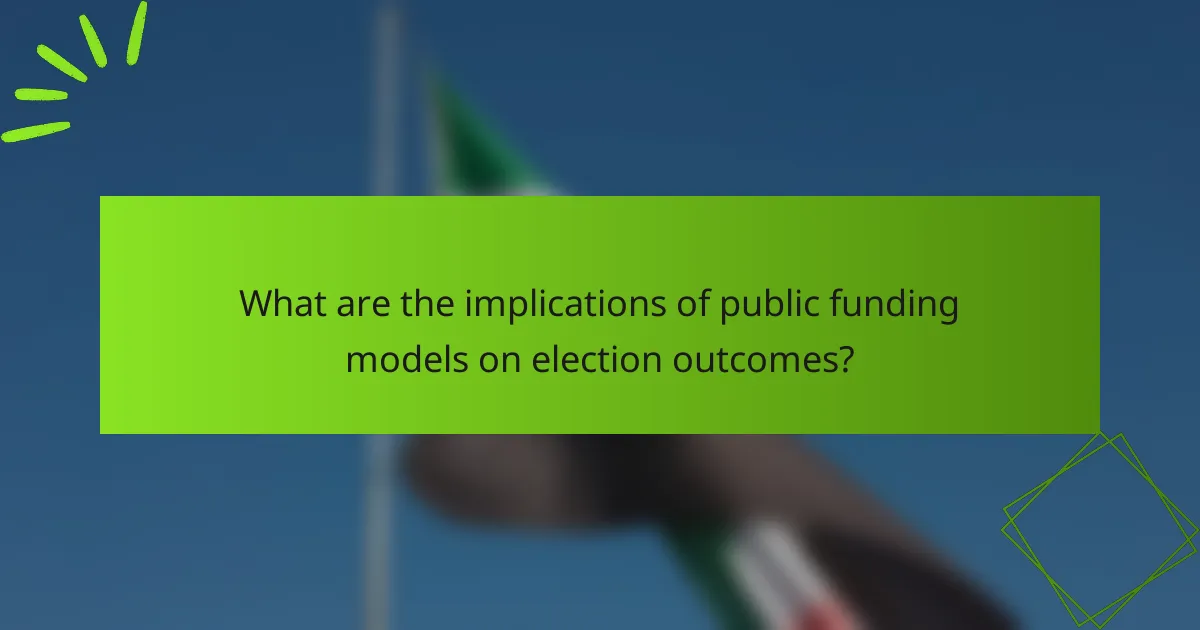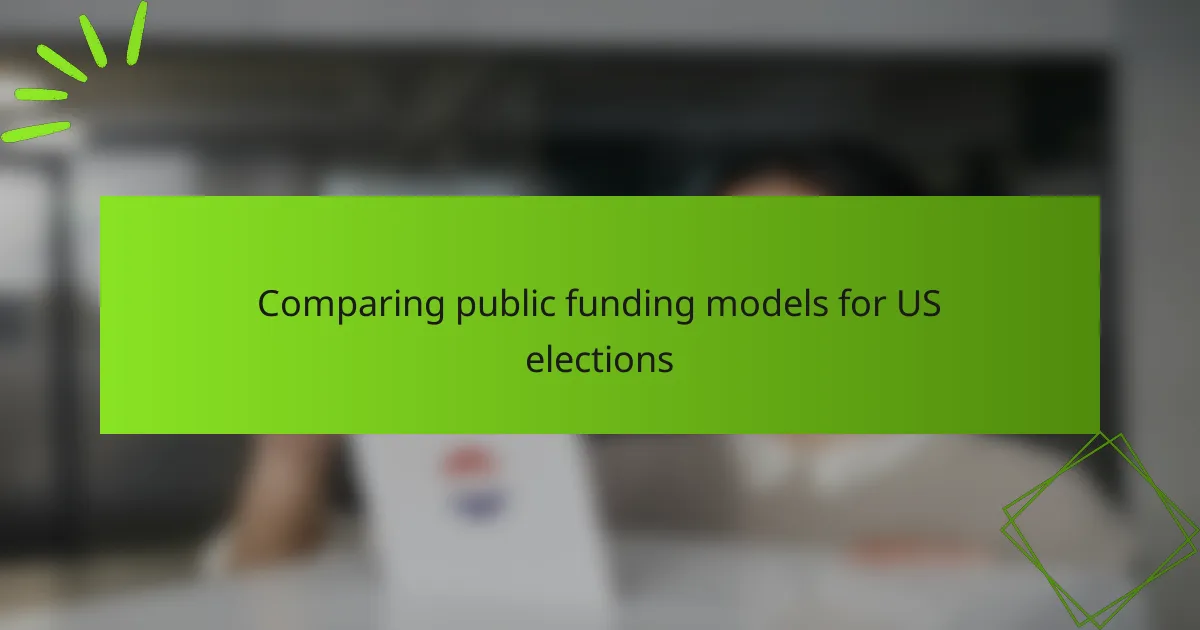Public funding models for US elections play a crucial role in shaping campaign dynamics and voter engagement. Key models include the Federal Election Commission (FEC) matching funds program, state-level public financing, and the voucher system, each designed to encourage grassroots support and limit the influence of large donors. The evolution of public funding began with the Federal Election Campaign Act of 1971 and has undergone significant changes, including the establishment of the Presidential Election Campaign Fund and the impact of the Bipartisan Campaign Reform Act of 2002. Ongoing debates about the effectiveness and fairness of these funding mechanisms highlight their potential to enhance electoral competition and increase voter turnout, ultimately influencing the political landscape.

What are the different public funding models for US elections?
Public funding models for US elections include the Federal Election Commission (FEC) matching funds program, state-level public financing, and the voucher system. The FEC matching funds program matches individual contributions to candidates up to a certain limit. This program aims to encourage small donations and increase grassroots support. State-level public financing varies by state and may include full or partial funding for candidates who agree to spending limits. The voucher system allows voters to allocate public funds to candidates of their choice. These models aim to reduce the influence of large donors and promote electoral competition.
How do these funding models vary across states?
Funding models for US elections vary significantly across states. Some states, like Arizona and Maine, offer comprehensive public financing options for candidates. These states provide full funding for campaigns if candidates agree to spending limits and raise a specified number of small contributions. Other states, such as Texas and Florida, do not have public financing systems. Instead, they rely heavily on private donations and party funding. Additionally, states like New York have recently implemented matching funds, where small donations are matched at a higher rate to encourage grassroots support. Overall, the differences in funding models reflect varying political cultures and approaches to campaign finance across the country.
What are the key characteristics of each funding model?
Public funding models for US elections include various characteristics. The key models are full public funding, matching funds, and partial public funding. Full public funding provides candidates with government funds to cover campaign expenses. This model aims to reduce the influence of private money in politics. Matching funds offer candidates additional public money based on private contributions. This encourages grassroots fundraising and increases candidate competitiveness. Partial public funding allows candidates to receive some government assistance while still relying on private donations. Each model has unique implications for campaign finance and electoral fairness. Research shows that public funding can lead to increased voter participation and more diverse candidates.
How does each model impact electoral competitiveness?
Each public funding model impacts electoral competitiveness differently. The matching funds model incentivizes candidates to raise private donations, enhancing competitiveness among candidates. This model can lead to more candidates entering the race, as it provides financial support based on fundraising efforts. Studies show that states with matching funds often see a greater number of candidates and more competitive elections.
In contrast, a flat funding model provides equal amounts to all candidates, regardless of fundraising. This can reduce the incentive for candidates to engage with voters and raise funds. Consequently, it may lead to less competitive races, as candidates may rely solely on public funds rather than building grassroots support.
Research indicates that states with matching funds experience higher voter engagement and participation. This is crucial for maintaining a vibrant democracy. Overall, the choice of funding model significantly shapes the electoral landscape and influences candidate behavior.
Why is public funding important for US elections?
Public funding is important for US elections because it aims to reduce the influence of private money in politics. It helps level the playing field for candidates, especially those with limited resources. Public funding encourages participation by providing financial support for campaign activities. This funding can lead to a more diverse range of candidates and ideas in the electoral process. Studies show that public financing can increase voter engagement and turnout. For example, states with public funding programs often see higher participation rates. Additionally, public funding enhances transparency and accountability in campaign financing. It allows voters to better understand where candidates’ financial support comes from.
What advantages does public funding provide to candidates?
Public funding provides candidates with financial resources to support their campaigns. This reduces reliance on private donations, allowing for more equitable competition. Candidates can focus on voter engagement rather than fundraising. Public funding can enhance transparency in campaign financing. It often requires candidates to adhere to spending limits, promoting fiscal responsibility. This system can increase voter trust in the electoral process. Research shows that public funding leads to higher participation rates among candidates from diverse backgrounds. A study by the Brennan Center for Justice found that public funding can lead to a more representative democracy.
How does public funding affect voter participation?
Public funding increases voter participation by reducing the influence of money in politics. When candidates rely on public funding, they can focus more on engaging with voters rather than fundraising. Studies show that public funding models lead to higher turnout rates. For example, states with public financing systems often report voter participation rates that exceed the national average. Research from the Brennan Center for Justice indicates that public funding can lead to a more diverse candidate pool. This diversity can attract a broader range of voters. Additionally, public funding can enhance voter trust in the electoral process. Trust in government correlates with higher voter turnout. Overall, public funding positively impacts voter engagement and participation in elections.

What are the historical developments of public funding in US elections?
Public funding in US elections has evolved significantly since its inception. The Federal Election Campaign Act of 1971 established the framework for public financing. This act allowed candidates to receive federal funds for their campaigns if they agreed to limit their spending. In 1974, amendments to this act created the Presidential Election Campaign Fund. This fund collects voluntary contributions from taxpayers to support presidential candidates.
In 1980, public funding expanded to include congressional elections, but this was not widely adopted. The 2002 Bipartisan Campaign Reform Act further changed the landscape by addressing soft money contributions. In 2008, the Obama campaign opted out of public funding, marking a shift in candidate preferences.
Recent discussions have focused on the effectiveness and fairness of public funding. Critics argue it does not level the playing field, while supporters claim it enhances democracy. Overall, public funding in US elections reflects ongoing debates about campaign finance and electoral integrity.
How have public funding models evolved over time?
Public funding models have evolved significantly over time in the context of U.S. elections. Initially, public funding was limited and primarily focused on presidential campaigns. The Federal Election Campaign Act of 1971 established the first federal funding mechanism for presidential candidates. This model provided matching funds for candidates who agreed to limit their spending.
In 1974, amendments to the Act expanded public funding to include full funding for major party candidates in presidential elections. This marked a shift towards more substantial government involvement in campaign financing. The introduction of the Presidential Election Campaign Fund allowed taxpayers to voluntarily contribute to a fund that supports public financing.
Over the years, various states have adopted their own public funding models for state and local elections. These models vary widely, with some states implementing systems that provide full funding based on specific criteria. For example, Arizona and Maine have established successful public financing programs that encourage small donations.
In recent years, there has been a push for reforms to address the influence of private money in politics. This has led to discussions about expanding public funding models to include more candidates and lower levels of government. The evolution of these models reflects ongoing debates about campaign finance, transparency, and the role of money in democracy.
Overall, public funding models have transitioned from limited federal support to more comprehensive systems at various governmental levels. This evolution continues to shape the landscape of U.S. elections and the financing of political campaigns.
What major legislation has influenced public funding?
The major legislation that has influenced public funding in US elections includes the Federal Election Campaign Act (FECA) of 1971. This act established regulations for campaign financing and introduced public funding for presidential elections. In 1974, amendments to FECA further expanded the public funding system. These amendments allowed candidates to receive federal matching funds for small donations. The Bipartisan Campaign Reform Act of 2002 also impacted public funding by banning soft money contributions to political parties. This legislation aimed to reduce the influence of money in politics. Each of these laws has shaped the landscape of public funding in US elections.
How have public attitudes towards funding models changed?
Public attitudes towards funding models have shifted towards increased support for public financing. Recent surveys indicate that more citizens favor public funding to reduce the influence of large donors. According to a 2021 Pew Research Center study, 63% of Americans believe that reducing the role of money in politics is essential. Additionally, younger voters show a stronger preference for public funding compared to older generations. This change reflects growing concerns about campaign finance and its impact on democracy. Public sentiment has increasingly favored transparency and accountability in political funding.
What challenges do public funding models face today?
Public funding models face challenges including limited resources and political opposition. Many public funding systems struggle with inadequate funding, which restricts their effectiveness. Additionally, there is often resistance from political groups that prefer private funding sources. Transparency issues also arise, as some models lack clear guidelines on fund allocation. Furthermore, public awareness and understanding of these models are often low. This leads to limited public support, impacting the sustainability of funding initiatives. Recent studies indicate that states with robust public funding models see better electoral participation. However, the overall effectiveness remains hindered by these persistent challenges.
What are the common criticisms of public funding systems?
Common criticisms of public funding systems include inefficiency, lack of accountability, and potential for misuse. Critics argue that public funding can lead to wasteful spending. They claim it may not effectively limit campaign costs. Some believe it incentivizes candidates to rely on government support rather than private donations. Additionally, there are concerns about transparency in how funds are allocated. Critics also point out that public funding might not significantly increase voter participation. Studies indicate that public funding systems can disproportionately benefit established candidates. Ultimately, these criticisms highlight the complexities of public funding in electoral processes.
How do recent court rulings impact public funding?
Recent court rulings significantly affect public funding for elections. These decisions often redefine the parameters of campaign finance laws. For instance, rulings like Citizens United v. FEC have allowed increased private funding in elections. This leads to a potential decrease in the reliance on public funding. Consequently, public funding may become less effective in leveling the electoral playing field. Additionally, courts have struck down limits on contributions, which can further diminish public funding’s role. These changes can create disparities in campaign resources among candidates. Overall, recent judicial interpretations challenge the viability of public funding models in U.S. elections.

What are the implications of public funding models on election outcomes?
Public funding models significantly influence election outcomes by shaping candidate competitiveness and voter engagement. These models can reduce reliance on private donations, which often leads to a more diverse candidate pool. For instance, candidates funded through public financing may focus on grassroots campaigning, appealing to a broader electorate. Studies indicate that public funding can increase voter turnout; for example, a report by the Brennan Center for Justice found that states with public funding saw higher participation rates. Additionally, public funding can mitigate the impact of money in politics, leveling the playing field between incumbents and challengers. This can lead to more competitive races and potentially alter the political landscape.
How do funding models affect candidate diversity?
Funding models significantly impact candidate diversity in elections. Public funding models can increase the number of diverse candidates by reducing financial barriers. When candidates have access to public funds, they can focus on campaigning rather than fundraising. This allows individuals from underrepresented backgrounds to enter the race. For example, research shows that states with public financing see higher participation rates from women and minorities. A study by the Brennan Center for Justice found that public financing in New York City led to a more diverse candidate pool. In contrast, reliance on private funding often favors wealthy individuals, limiting diversity. Thus, the type of funding model directly influences the demographic representation among candidates.
What role does public funding play in supporting underrepresented candidates?
Public funding plays a crucial role in supporting underrepresented candidates. It provides financial resources that help these candidates overcome barriers to entry in elections. Many underrepresented individuals lack access to traditional fundraising networks. Public funding levels the playing field by offering funds based on specific criteria, such as matching small donations. For instance, the New York City public matching system matches small donations at a rate of 8 to 1. This encourages grassroots support and increases campaign viability. Research indicates that public funding can lead to more diverse candidate pools. A study by the Brennan Center for Justice found that public financing systems can increase the number of candidates from marginalized communities. Overall, public funding enhances electoral participation and representation for underrepresented groups.
How do funding models influence campaign strategies?
Funding models significantly influence campaign strategies by determining resource allocation and messaging priorities. Campaigns relying on public funding often focus on broad outreach to engage a larger electorate. This contrasts with privately funded campaigns, which may prioritize targeted advertising to affluent demographics. Public funding encourages candidates to develop inclusive policies that resonate with diverse voter bases. In contrast, private funding can lead to a focus on issues that align with donors’ interests. Historical trends show that candidates with public funding tend to emphasize grassroots engagement. Conversely, those with private funding often invest heavily in media buys. Thus, the type of funding model shapes strategic decisions on outreach, policy focus, and voter engagement methods.
What best practices can be adopted for effective public funding?
Best practices for effective public funding include transparency, accountability, and stakeholder engagement. Transparency ensures that funding sources and allocations are clear to the public. This can build trust in the funding process. Accountability mechanisms should be in place to track how funds are used. Regular audits can help maintain integrity in the system. Stakeholder engagement involves including community input in funding decisions. This can lead to more equitable distribution of resources. Research indicates that jurisdictions with these practices report higher satisfaction with public funding outcomes. For instance, the Pew Charitable Trusts highlights that transparent funding models improve public confidence in government.
What lessons can be learned from successful funding models in other countries?
Successful funding models in other countries demonstrate the effectiveness of diverse financing approaches. Countries like Sweden and Canada utilize public financing to promote electoral fairness. These models reduce reliance on private donations, ensuring more equitable competition among candidates. For instance, Sweden’s system allocates public funds based on electoral performance, incentivizing participation. Additionally, Canada employs a matching funds system to amplify small donations, encouraging grassroots support. Studies show that public funding enhances voter turnout and candidate diversity. Implementing similar strategies in the U.S. could address funding disparities and improve democratic engagement.
How can transparency be improved in public funding systems?
Transparency in public funding systems can be improved through the implementation of standardized reporting requirements. These requirements should mandate detailed disclosures of funding sources and expenditures. Publicly accessible online databases can facilitate this transparency. Such databases allow citizens to track how funds are allocated and spent. Regular audits by independent third parties can enhance accountability. Additionally, clear communication strategies can inform the public about funding processes. According to the Center for Responsive Politics, transparency can lead to increased public trust in funding systems. Implementing these strategies can significantly improve transparency in public funding systems.
The main entity of this article is public funding models for US elections. The article provides a detailed comparison of various public funding models, including the Federal Election Commission (FEC) matching funds program, state-level public financing, and the voucher system. It examines how these models vary across states, their key characteristics, and their impact on electoral competitiveness and voter participation. Additionally, the article discusses historical developments, public attitudes, challenges, and best practices related to public funding systems, highlighting their implications for candidate diversity and electoral outcomes.
